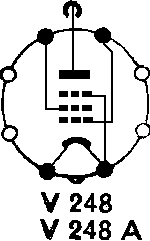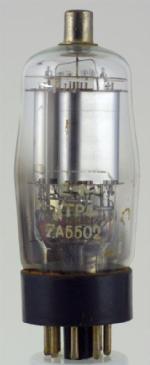
ATP4
|
|
|||||||||||||||||||||||||||||||||||||
|
Vus: 3154 Répondre: 0
Heizspannung der ATP4
|
|||||||||||||||||||||||||||||||||||||||||||||||||||||||||||||||||||
|
Jacob Roschy
03.Aug.11 |
1
Es kursieren widersprüchliche Angaben zur Heizspannung der ATP4 von wahlweise 2,0 oder 2,6 V, wobei die Richtigkeit dieser Angaben nicht eindeutig festzulegen ist. Für 2,0 V spricht die Glühfarbe, welche der normaler 2 V- Batterieröhren entspricht, bei 2,6 V glüht der Faden schon ungewöhnlich hell. Für 2,0 V spricht auch, dass diese Röhre sehr wahrscheinlich von der QP230 abgeleitet wurde, ebenfalls mit Heizdaten 2,0 V / 0,3 A, sowie die Tatsache, dass die meisten anderen Röhren dieser englischen Armee- Batterieröhrenserie, z. B. ARP12, ebenfalls für 2 V ausgelegt sind, jedoch keine weiteren Röhren mit 2,6 V darunter zu finden sind. Sowohl bei der Heizspannungsangabe 2,0 V wie auch bei der Angabe 2,6 V werden stets 0,3 A als Heizstrom angegeben. Da dies physikalisch unmöglich ist, wurde eine Versuchsserie mit 10 Röhren ATP4 durchgeführt, wobei bei einem vorgegebenen Heizstrom von 300 mA die Heizspannung gemessen wurde und bei einer vorgegebenen Heizspannung von 2,6 V der Heizstrom gemessen wurde.
Es zeigte sich, dass bei 300 mA Heizstrom die Heizspannung stets in der Nähe von 2 V liegt und bei einer Heizspannung von 2,6 V der Heizstrom stets in der Nähe von 360 mA liegt. Daraus lässt sich eindeutig schließen, dass 2,0 V / 0,3 A die richtigen Heizdaten sind. Eine Angabe im „Codex“ bedeutet nicht automatisch, dass sie falsch sein muss und eine Angabe in einer „Specification MOS/CV1366/ Issue 6, dated 2.9.1946 by Ministry of supply (S.R.D.E.)“, bedeutet nicht automatisch, dass sie richtig sein muss. Die Angabe der Heizspannung von 2,6 V kann von einer schlecht geschriebenen handschriftlichen Notiz stammen, wobei eine 0 als 6 gelesen wurde. Eine willkürlich angegebene Überheizung ist nicht ganz auszuschließen, jedoch stimmt dann der zugehörige Heizstrom 0,3 A nicht.
M. f. G. J. R. |
||||||||||||||||||||||||||||||||||||||||||||||||||||||||||||||||||
|
Vus: 3969 Répondre: 4
The ATP4 heater voltage
|
|||||||||||||||||||||||||||||||||||||||||||||||||||||||||||||||||||
|
Jacob Roschy
03.Aug.11 |
1
There is contradictory information circulating about the heater voltage of the ATP4 of either 2.0 or 2.6 V. It seems not to be clear which of this information is correct. 2.0 V speaks for the filament glow color, which corresponds to the normal 2V - battery tubes, but at 2.6 V, the filament glows even unusually bright. Also for 2.0 V calls the fact that this tube was very likely derived from the QP230, which has also the heater figures 2.0 V / 0.3 A, and the fact that most of the other tubes in this English army battery tube series, eg. the ARP12, are also rated at 2.0 V, but no other tubes with 2.6 V can be found. Both in the heater voltage specifications of 2.0 V as well as 2.6 V a heater current of 0.3 A is given. Since this is physically impossible, a series of experiments with 10 tubes ATP4 was performed with voltage measurements at a given heater current of 300 mA as well current measurements as at a given heater voltage of 2.6 V.
It was found that at 300 mA heater current the filament voltage is always close to 2 V, and at a heater voltage of 2.6 V, the heater current is always in the vicinity of 360 mA. This clearly suggests that 2.0 V / 0.3 A must be the proper heater figures ! A statement in the "Codex" does not automatically mean that it must be wrong, and an indication in a "Specification MOS/CV1366 / Issue 6, dated 09/02/1946 by Ministry of Supply (SRDE)" does not automatically mean as being correct. The specification of the heating voltage of 2.6 V could have been occurred by a poorly written handwritten note, where a number 0 was read as 6. A deliberately specified overheating is not entirely ruled out, but is not related to the heater current 0.3 A.
|
||||||||||||||||||||||||||||||||||||||||||||||||||||||||||||||||||
|
Emilio Ciardiello
03.Aug.11 |
2
Dear Jacob, probably the contradiction in the filament voltage arises from the reading of the CV spec sheet as a normal data sheet of a tube. But we must think of this sheet as the document for the acceptance, or even the reject, of any production lot by Military. In the introduction we find generic data on the tube, kind of cathode, sometimes materials used for electrodes, base and pinout and operating voltages and currents. The second section is dedicated to the acceptance tests and to test procedures. Now we read 2.6 volts and 300 milliamps as ratings of the tube. This means that the tube was designed for operation centered around these values. Then we jump to the acceptance tests, page 2 of the sheet, an here we find that filament current, plate current and other tests must be in agreement with the specified values or ranges when the filament voltage is set at 2.0 volts. No wonder that emission and other critical parameters were measured at the lowest espected heater voltage. Unfortunately the CV spec is at the moment the only source of information for this tube and we should believe it accurate, since was used through the years for all the tubes bought all over the Commonwealth. Regards, Emilio |
||||||||||||||||||||||||||||||||||||||||||||||||||||||||||||||||||
|
Emilio Ciardiello
04.Aug.11 |
3
More info came out on this tube. Regards, Emilio |
||||||||||||||||||||||||||||||||||||||||||||||||||||||||||||||||||
|
Jan Terranea
04.Aug.11 |
4
The ATP4 is the also transmitting penthode in WS38 and WS38AFV. The WS38 has a heater-battery of nominal 3 volts, and the heater of this tube is fed via an 1,7 ohms resistor, giving a drop of about 0,5 volts. I use this WS38 from time to time, and I have noticed that the set works okay with 2 nicad-cells in series, giving 2,2 volts working tension, resulting in about 1,8 volts at the valve. The WS38 AFV uses the car-battery of nominal 12 volts for heating. It has 2 ATP4 valves, ( one in the separate power-supply/LF-amplifier) that get their heaters fed in series via a 24 ohms resistor. This rsistor gives a drop of 8 volts at 0,3 Amp, leaving 4 volts for the 2 valves in series. In my opinion 2 volts must be considered to be the normal heating-voltage.
|
||||||||||||||||||||||||||||||||||||||||||||||||||||||||||||||||||
|
Jacob Roschy
05.Aug.11 |
5
From the findings of the previous discussion, I conclude that the center design heater voltage of the ATP4 must be around 2.3 volts. Therefore a new test series with 15 tubes ATP4 was conducted to see which average heater current appears at 2.3 volts, which happens to be 336 mA. Those tubes that corresponded to this average value are drawing 307 mA at 2.0 V as well as 368 mA at 2.6 V. Summary of the average heater current: 307 mA at 2.0 V 336 mA at 2.3 V (may be considered as center design values) 368 mA at 2.6 V. January Terranea gave us valuable information about real applications of ATP4. With this information it was possible to trace back the voltages the ATP4 was heated with. Hence, in another experiment, a ATP4 was heated via a resistor of 1.7 Ω at voltages of 2.6 to 3 V. It was found out: at 3.0 V: I-f = 348 mA, U-f = 2.41 V at 2.8 V: I-f = 331 mA, U-f = 2.25 V, regarding internal resistance and partially discharge of a dry-cell battery, at 2.6 V: I-f = 312 mA, U-f = 2.07 V, regarding progressed discharge. Now two ATP4's in series connection was heated via a resistor of 24 Ω at voltages of 12 to 14 V. It was found out: at 12 V: I-f = 323 mA, U-f = 4.36 V for both tubes, makes 2.18 V per tube, corresponding to a car battery in discharge mode, at 13 V: I-f = 346 mA, U-f = 4.80 V for both tubes, makes 2.4 V per tube, at 14 V: I-f = 368 mA, U-f = 5.22 V for both tubes, makes 2,61 V per tube, corresponding to a car battery in charging mode via the generator. It looks as the center design heater voltage of the ATP4is is about 2.3 to 2.4 volts. A 2.4 V rechargeable battery may be the ideal voltage supply. Of course any experiments was made without plate and screen current, which also will have a considerable influence. Best Regards, Jacob |
||||||||||||||||||||||||||||||||||||||||||||||||||||||||||||||||||
|
Vus: 3135 Répondre: 2
ATP4 - ZA5502 welcher Eintrag ist nun richtig?
|
|
|
Pius Steiner
04.Feb.06 |
1
guten Tag zusammen in einer Kiste meines Vaters fand ich die beigelegte Röhre, die mit ATP4 und ZA5502 beschriftet ist. Nun wollte ich ein Bild der Röhre hochladen und fand beide Typen erfasst. Kann es sein dass ATP4 mit ZA5502 identisch ist und bei welcher Röhre soll ich das Bild hochladen. Besten Dank Pièces jointes
|
|
Hans-Thomas Schmidt
04.Feb.06 |
2
Hallo Herr Steiner, ja, es gibt beide Bezeichnungen für die gleiche Röhre. Es gibt sogar noch eine Dritte: V248A. Die Typen habe ich verknüpft. Bitte laden Sie das Bild auf beide Röhrentypen hoch. Eine Besonderheit hat Ihre ATP4, einen etwas unsymmetrischen Oktalsockel, wie er für einige britische Miltitärröhren verwendet wurde. Viele Grüße, H.-T. Schmidt |
|
Pius Steiner
04.Feb.06 |
3
vielen Dank Herr Schmidt das Bild habe ich nun auf ATP4 und ZA5502 geladen. wünsche ein schönes Wochenende |
Fin des contributions forum pour ce composant
| Mentions légales | Plus d'informations |




